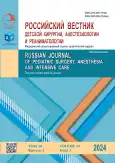一例7个月大儿童肺叶外隔离和气管支气管的内外科治疗
- 作者: 埃雷明 德.B.1, Gadzhikerimov G.E.2, Tukhtamatov A.A.2, Demidov A.A.2
-
隶属关系:
- G.N. Speransky Children’s Hospital No. 9
- Pirogov Russian National Research Medical University
- 期: 卷 14, 编号 3 (2024)
- 页面: 421-430
- 栏目: Case reports
- URL: https://journal-vniispk.ru/2219-4061/article/view/268218
- DOI: https://doi.org/10.17816/psaic1813
- ID: 268218
如何引用文章
全文:
详细
根据文献资料,肺畸形的诊断率在过去十年中显著增加,为1:25 00-3000新生儿。肺隔离是一种发育异常,表现为独立的无功能肺组织碎片,与支气管树不相连,由主动脉或大循环动脉供血。肺隔离症占所有肺畸形的0.15-6.4%。本文报告了一例7个月大女孩小叶外肺隔离症的临床病例。孩子入院时主诉咳嗽、嘈杂、呼吸急促,有胃食管反流诊所病史,居住地排除胃肠病学。通过对该患者的回顾性分析,明确了产前未发现畸形。体格检查时听到两侧湿啰音,呼吸频率为每分钟 36 次,胸部 X 光片显示为右侧上叶肺炎。诊断结果为:“院外右侧上叶肺炎,中重度。DN0-1期”。在对胸部器官进行对比CT扫描时,发现了先天性畸形——右侧气管支气管,右侧肺叶外隔离。制定了微创干预的适应症。 在胸腔镜手术治疗期间,在半胸后部发现肺外隔离,营养血管来自胸主动脉,并进行了隔离切除术。术后期间,在抗菌、输液、对症治疗的背景下,观察到积极的动态,患儿出院情况满意。对于患有长期、复发性肺部感染的儿童,在保守治疗的背景下没有积极的动态,特别是在体温正常且血液检查中没有炎症迹象的背景下存在呼吸系统疾病的情况下,有必要排除先天性呼吸道畸形。对比增强计算机断层扫描和随后的三维重建是诊断肺隔离症信息最丰富的方法。目前,胸腔镜下切除单个无功能肺组织碎片是一种有效的微创手术治疗方法。
作者简介
德米特里 埃雷明
G.N. Speransky Children’s Hospital No. 9
Email: bosya100707@gmail.com
ORCID iD: 0000-0002-7144-0877
SPIN 代码: 2558-8291
MD, Cand. Sci. (Medicine)
俄罗斯联邦, 123317, Moscow, Shmitovsky proezd, 29Gadzhikerim Gadzhikerimov
Pirogov Russian National Research Medical University
Email: gk.medik@list.ru
ORCID iD: 0000-0002-0142-2163
SPIN 代码: 5960-2603
俄罗斯联邦, 1 Ostrovityanova st., Moscow, 117997
Abdumazhid Tukhtamatov
Pirogov Russian National Research Medical University
Email: abdumajid2225@mail.ru
ORCID iD: 0009-0008-9919-9473
MD
俄罗斯联邦, 1 Ostrovityanova st., Moscow, 117997Alexandr Demidov
Pirogov Russian National Research Medical University
编辑信件的主要联系方式.
Email: demidoval10@list.ru
ORCID iD: 0000-0002-0788-9354
SPIN 代码: 5568-8660
MD, Cand. Sci. (Medicine)
俄罗斯联邦, 1 Ostrovityanova st., Moscow, 117997参考
- Tumanova UN, Dorofeeva EI, Podurovskaya YuL, et al. Pulmonary sequestration: classification, diagnostics, treatment. Pediatriya. Zhurnal Im G.N. Speranskogo. 2018;97(2):163–171. EDN: TGEMMB doi: 10.24110/0031-403x-2018-97-2-163-171
- Pinto Filho DR, Avino AJ, Brandão SL. Extralobar pulmonary sequestration with hemothorax secondary to pulmonary infarction. J Bras Pneumol. 2009;35(1):99–102. doi: 10.1590/s1806-37132009000100015
- Sulhyan KR, Ramteerthakar NA, Gosavi AV, Anvikar AR. Extralobar sequestration of lung associated with congenital diaphragmatic hernia and malrotation of gut. Lung India. 2015;32(4):381–383. doi: 10.4103/0970-2113.159585
- Okunev NA, Kemaev AB, Okuneva AI, et al. Pulmonary sequestration: case repot. Journal of Pediatric Surgery. 2016;20(3):164–166. EDN: WAXAOZ doi: 10.18821/1560-9510-20-3-164-166
- Dave MH, Gerber A, Bailey M, et al. The prevalence of tracheal bronchus in pediatric patients undergoing rigid bronchoscopy. J Bronchology Interv Pulmonol. 2014;21(1):26–31. doi: 10.1097/lbr.0000000000000029
- Berrocal T, Madrid C, Novo S, et al. Congenital anomalies of the tracheobronchial tree, lung, and mediastinum: embryology, radiology, and pathology. RadioGraphics. 2004;24(1):e17. doi: 10.1148/rg.e17
- Ruchonnet-Metrailler I, Abou Taam R, Blic J. Presence of tracheal bronchus in children undergoing flexible bronchoscopy. Respir Med. 2015;109(7):846–850. doi: 10.1016/j.rmed.2015.04.005
- Al-Naimi A, Hamad S, Abushahin A. Tracheal bronchus and associated anomaly prevalence among children. Jornal Cureus. 2021;13(5):e15195. doi: 10.7759/cureus.15192
- Suzuki M, Matsui O, Kawashima H, et al. Radioanatomical study of a true tracheal bronchus using multidetector computed tomography. Jpn Radiol. 2010;28(3):188–192. doi: 10.1007/s11604-009-0405-5
- Chakraborty RK, Modi P, Sharma S. Pulmonary sequestration. In: StatPearls [Internet]. Treasure Island (FL): StatPearls; 2024.
- Corbett HJ, Humphrey GM. Pulmonary sequestration. Paediatr Respir Rev. 2004;5(1):59–68. doi: 10.1016/j.prrv.2003.09.009
- Singh R, Davenport M. The argument for operative approach to asymptomatic lung lesions. Semin Pediatr Surg. 2015;24(4):187–195.doi: 10.1053/j.sempedsurg.2015.02.003
- Flanagan SR, Vasavada P. Intralobar pulmonary sequestration: a case report. Cureus. 2023;15(10):e46794. doi: 10.7759/cureus.46794
- Ojha V, Samui PP, Dakshit D. Role of endovascular embolization in improving the quality of life in a patient suffering from complicated intralobar pulmonary sequestration – a case report. Respir Med Case Rep. 2015;16):24–28. doi: 10.1016/j.rmcr.2015.02.011
- Riley JS, Urwin JW, Oliver ER, et al. Prenatal growth characteristics and pre/postnatal management of bronchopulmonary sequestrations. J Pediatr Surg. 2018;53(2):265–269. doi: 10.1016/j.jpedsurg.2017.11.020
- Bhavsar VD, Jaber JF, Rackauskas M, Ataya A. Intralobar pulmonary sequestration presenting as recurrent left lower lobe pneumonia. Proc (Bayl Univ Med Cent). 2023;36(6):767–769. doi: 10.1080/08998280.2023.2258318
- Grebnev PN, Osipov AJ. Diagnosis and surgical treatment of pulmonary sequestration in children. Practical Medicine. 2010;45:141–143.
- Phelps MC, Sanchirico PJ, Pfeiffer DC. Intralobar pulmonary sequestration: incidental finding in an asymptomatic patient. Radiol Case Rep. 2020;15(10):1891–1894. doi: 10.1016/j.radcr.2020.07.057
- Wei Y, Li F. Pulmonary sequestration: a retrospective analysis of 2625 cases in China. Eur J Cardiothorac Surg. 2011;40(1):е39–е42. doi: 10.1016/j.ejcts.2011.01.080
- Mughrabi A, Fennelly J, Fandreyer F, Fleisher J. Unravelling the mystery of a rare infection: a challenging case of pulmonary sequestration with Mycobacterium avium complex and the importance of a thorough microbiological investigation. J BMJ Case Rep. 2023;16(9):e255346. doi: 10.1136/bcr-2023-255346
- Mon RA, Johnson KN, Ladino-Torres M, et al. Diagnostic accuracy of imaging studies in congenital lung malformations. Arch Dis Child Fetal Neonatal Ed. 2018;104(4):F372–F377. doi: 10.1136/archdischild-2018-314979
- Ko SF, Ng SH, Lee TY, et al. Noninvasive imaging of bronchopulmonary sequestration. AJR Am J Roentgenol. 2000;175(4):1005–1012. doi: 10.2214/ajr.175.4.1751005
- Sun X, Xiao Y. Pulmonary sequestration in adult patients: a retrospective study. Eur J Cardiothorac Surg. 2014;48(2):279–282. doi: 10.1093/ejcts/ezu397
- Kas J, Fehér C, Heiler Z, et al. Treatment of adult intrapulmonary sequestration with video-assisted thoracoscopic lobectomy. Magy Seb. 2018.71(3):126–133. doi: 10.1556/1046.71.2018.3.3
- Moreno M, Castillo-Corullón S, Pérez-Ruiz E, et al. Spanish multicentre study on morbidity and pathogenicity of tracheal bronchus in children. Pediatr Pulmonol. 2019;54(10):1610–1616. doi: 10.1002/ppul.24435
- García-Hernández C, Carvajal FL, Celorio AÁ, et al. Thoracoscopic lobectomy for the treatment of tracheal bronchus. A pediatric case report. Cir Cir. 2017;85(6):557–561. doi: 10.1016/j.circir.2016.10.010
- Bazhenov AV, Motus IYa, Berdnikov RB, Romahin AS. Pulmonary sequestrations. Pulmonologiya. 2023;33(5):690–696. doi: 10.18093/0869-0189-2023-33-5-690-696
- Dubova EA, Pavlov KA, Kucherov YI, et al. Extrapulmonary sequestration of lung. Russian journal of pediatric surgery, anesthesia and intensive care. 2011;(2):53–59. EDN: OPUNVV
- Shulutko AM, Yasnogorodskiy OO, Taldykin MV, et al. A case of diagnosis and treatment of intrapulmonary sequestration in a 34-year-old woman. RMJ. 2014;22(30):2166–2168.
- Dubova EA, Pavlov KA, Shchegolev AI, et al. Retroperitoneal lung sequestration in a newborn. Obstetrics and gynecology. 2011;7(2):83–86.
补充文件










